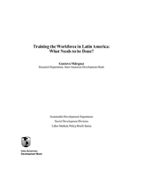Training the Workforce in Latin America: What Needs to be Done?
Date
Nov 2001
The purpose of this paper is to discuss the status of training policies in Latin America, and to review some new approaches that are shaping the evolution of policies and institutions in the region. The ideas presented here rely heavily on discussions held over the last five years with government, private sector, and union officials in a number of countries in the region about organizational, institutional, and financial changes of training institutions. As such, this paper presents just a snapshot of a very active and lively discussion about training institutions and policies, where new lessons are being learned and new approaches are being developed practically every day. In the first section the authors discuss why and how training policies are a legitimate and important object of public policies. Next, they discuss the institutional structure of the training systems in Latin America at the light of their adequacy to coordinate the acquisition and use of skills by the work force. Training systems in the region have evolved differently from a common original model, mostly as a consequence of the different sets of circumstances and institutional capabilities that governments, the private sector, and unions had in each country. The adoption of the wide set of policies proposed here will be of course a gradual process, and needs to be tailored to the particular circumstances and capabilities each country faces. The findings presented here add up to a wider vision of the tools that policy makers have when trying to provide the population at large with the level and mix of skills needed by workers and firms to create the more productive jobs associated with a more competitive economy.



